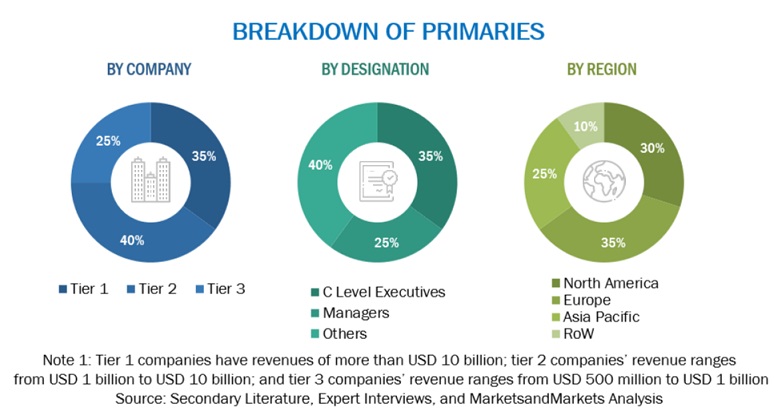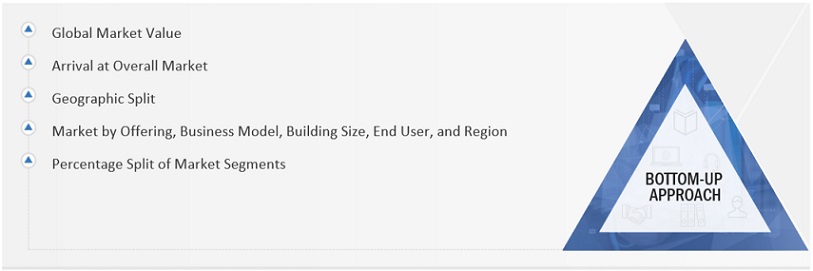The research study involved four major activities in estimating the in-building wireless market size. Exhaustive secondary research has been done to collect important information about the market and peer markets. The next step has been to validate these findings and assumptions and size them with the help of primary research with industry experts across the value chain. Both top-down and bottom-up approaches have been used to estimate the market size. Post which the market breakdown and data triangulation have been adopted to estimate the market sizes of segments and sub-segments.
Secondary Research
The market size of the companies offering in-building wireless to various end users was arrived at based on the secondary data available through paid and unpaid sources and by analyzing the product portfolios of major companies in the ecosystem and rating the companies based on their performance and quality. In the secondary research process, various sources were referred to identify and collect information for the study. The secondary sources included annual reports, press releases, investor presentations of companies, white papers, certified publications, and articles from recognized associations and government publishing sources. Several journals were also referred to, such as the International Journal of Computer Science and Information Technology and Security (IJCSITS), ScienceDirect, ResearchGate, Academic Journals, and Scientific.Net; and various DAS and small cells associations/forums, Citizens Broadband Radio Service (CBRS) Alliance, MulteFire Alliance, and 3rd Generation Partnership Project (3GPP).
Secondary research was used to obtain critical information about the industry’s supply chain, the total pool of key players, market classification and segmentation according to the industry trends to the bottom-most level, regional markets, and key developments from market- and technology-oriented perspectives, all of which were further validated by primary sources.
Primary Research
In the primary research process, various sources from the supply and demand sides were interviewed to obtain qualitative and quantitative information for the report. The primary sources from the supply side included Chief Executive Officers (CEOs), Chief Technology Officers (CTOs), Chief Operating Officers (COOs), Vice Presidents (VPs), Managing Directors (MDs), technology and innovation directors, and related key executives from various key companies and organizations operating in the in-building wireless market.
Primary interviews were conducted to gather insights, such as market statistics, data on revenue collected from software and services, market breakups, market size estimations, market forecasts, and data triangulation. Stakeholders from the demand side, such as Chief Information Officers (CIOs), Chief Finance Officers (CFOs), Chief Strategy Officers (CSOs), and the installation team of end users who use in-building wireless, were interviewed to understand buyers’ perspectives on suppliers, products, service providers, and their current usage of in-building wireless solution and services, which is expected to affect the overall in-building wireless market growth.

To know about the assumptions considered for the study, download the pdf brochure
Market Size Estimation
In the market engineering process, the top-down and bottom-up approaches were used along with multiple data triangulation methods to estimate and validate the size of the in-building wireless market and other dependent submarkets. The research methodology used to estimate the market sizes includes the following:
-
Initially, MarketsandMarkets focuses on top-line investments and spending in the ecosystems. Further, significant developments in the critical market area have been considered.
-
Tracking the recent and upcoming developments in the in-building wireless market that include investments, R&D activities, product launches, collaborations, mergers and acquisitions, and partnerships, as well as forecasting the market size based on these developments and other critical parameters.
-
Conduct multiple discussions with key opinion leaders to learn about the diverse types of authentications and brand protection offerings used and the applications for which they are used to analyze the breakdown of the scope of work carried out by major companies.
-
Segmenting the market based on technology types concerning applications wherein the types are to be used and deriving the size of the global application market.
-
Segmenting the overall market into various market segments
-
Validating the estimates at every level through discussions with key opinion leaders, such as chief executives (CXOs), directors, and operation managers, and finally with the domain experts at MarketsandMarkets
Market Size Estimation Methodology-Bottom-up approach

To know about the assumptions considered for the study, Request for Free Sample Report
Market Size Estimation Methodology-top-down approach

Data Triangulation
After arriving at the overall market size from the above estimation process, the in-building wireless market has been split into several segments and sub-segments. To complete the overall market engineering process and arrive at the exact statistics for all segments and sub-segments, data triangulation and market breakdown procedures have been used, wherever applicable. The data has been triangulated by studying various factors and trends from both the demand and supply sides.
The in-building wireless market size has been validated using top-down and bottom-up approaches.
Market Definition
In-building wireless is a system installed in different types of buildings to offer more robust mobile coverage for mobile users inside the building. The Distributed Antenna System (DAS) and small cells are the most used in-building wireless solutions. These solutions enhance the mobile network coverage inside a designated area, improve the quality of mobile signals, and extend the network coverage to every part of the building, enabling efficient and reliable access to voice and data services.
Stakeholders
-
Network infrastructure enablers
-
Technology vendors
-
Mobile Network Operators (MNOs)
-
Independent Software Vendors (ISVs)
-
Communication Service Providers (CSPs)
-
System Integrators (SIs)
-
Neutral host operators
-
Resellers
-
Value-added Resellers (VARs)
-
Managed Service Providers (MSPs)
-
Compliance regulatory authorities
-
Government authorities
-
Investment firms
-
Cloud service providers
-
In-building wireless alliances/groups
-
Original Design Manufacturers (ODMs)
-
Original Equipment Manufacturers (OEMs)
-
Enterprises/businesses
Report Objectives
-
To determine and forecast the global in-building wireless market by offering, business model, building size, end user, and region from 2024 to 2029, and analyze the various macroeconomic and microeconomic factors affecting market growth.
-
To forecast the size of the market segments concerning five central regions: North America, Europe, Asia Pacific (APAC), Middle East & Africa (MEA), and Latin America.
-
To provide detailed information about the major factors (drivers, restraints, opportunities, and challenges) influencing the growth of the in-building wireless market.
-
Analyze each submarket concerning individual growth trends, prospects, and contributions to the overall in-building wireless market.
-
To analyze the opportunities in the market for stakeholders by identifying the high-growth segments of the in-building wireless market.
-
To profile the key market players; provide a comparative analysis based on business overviews, regional presence, product offerings, business strategies, and key financials; and illustrate the market’s competitive landscape.
-
Track and analyze competitive developments in the market, such as mergers and acquisitions, product developments, partnerships and collaborations, and Research and Development (R&D) activities.
Available Customizations
With the given market data, MarketsandMarkets offers customizations per the company’s specific needs. The following customization options are available for the report:
Geographic Analysis
-
Further break-up of the Asia Pacific market into countries contributing 75% to the regional market size
-
Further break-up of the North American market into countries contributing 75% to the regional market size
-
Further break-up of the Latin American market into countries contributing 75% to the regional market size
-
Further break-up of the Middle East African market into countries contributing 75% to the regional market size
-
Further break-up of the European market into countries contributing 75% to the regional market size
Company Information
-
Detailed analysis and profiling of additional market players (up to 5)



Growth opportunities and latent adjacency in In-building Wireless Market